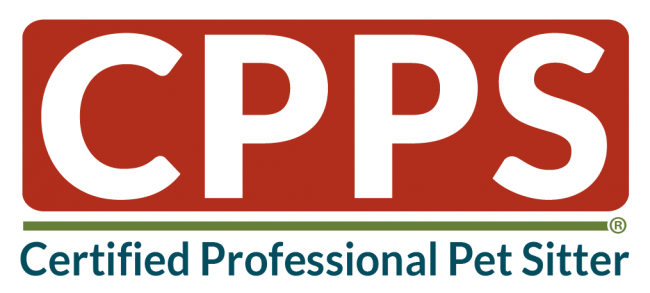CPPS Exam Study Objectives
Every professional pet sitter knows that a pet sitter is more than just a pet lover. Professional pet sitting demands a wide range of skill sets, from pet care and customer service to sanitation and business management. Those of you who have not only met, but mastered these skills, deserve recognition as the best the pet-sitting industry has to offer.
By passing the CPPS Exam, you demonstrate your excellence, not only to your professional pet sitting peers, but to the pet-owning public at large.
The CPPS-Certified Professional Pet Sitter Exam® is designed to assess the knowledge required to be a professional pet sitter and as you can see in the outline of subjects covered by this exam, we have all of our bases covered!
Just entering the industry and not ready to test for the CPPS designation? PSI offers an online certificate course, Professional Pet Sitting as a Career, which provides the need-to-know information for starting and growing your own professional pet-sitting service.

Pet Sitting General Body of Knowledge/CPPS-Certified Professional Pet Sitter Exam Study Objectives:
A. Domain: Pet Care
1. Pet Sitting
- a. Define pet sitting and how it differs from in-home boarding.
- b. Describe how a typical pet sitting visit is conducted.
2. Dogs
- a. Demonstrate knowledge of canine behavior and body language, as well as techniques for breaking up dog fights.
- b. Identify the dietary and exercise needs of canines.
- c. Understand the basic anatomy, as well as growth and development stages, of dogs.
- d. Recognize the different styles of collars, harnesses and leashes and explain the purpose of each.
- e. Understand common diseases that affect canines and how to recognize signs of illness.
3. Cats
- a. Demonstrate knowledge of feline behavior and body language.
- b. Identify the dietary and exercise needs of felines.
- c. Understand the basic anatomy, as well as growth and development stages, of cats.
- d. Recognize the different litter types and best technique for cleaning each.
- e. Understand common diseases that affect felines and how to recognize signs of illness.
B. Domain: Health, Sanitation and Safety
1. Animal First Aid and Health
- a. Understand the importance of regular physical assessments of pets and demonstrate knowledge of how to perform one.
- b. Understand how to perform basic pet first aid functions, such as bandaging a cut, initial treatment for heatstroke, rescue breathing and chest compressions.
- c. Understand techniques for administering medications to cats and dogs.
2. Parasites and Sanitation
- a. Identify common pet parasites and zoonotic diseases.
- b. Demonstrate knowledge of how to sanitize pet stains and the best methods to dispose of waste.
- c. Recognize the importance of containing diseases and understand how to take steps to prevent their spread.
3. Pet Safety
- a. Demonstrate knowledge of common household and seasonal hazards that can affect pets.
- b. Understand steps pet sitters can take to prevent pets from escaping their care, as well as steps to take in the event a pet goes missing.
- c. Demonstrate knowledge of how to get cats and dogs into crates and how to safely transport them in vehicles.
4. Pet Loss
- a. Understand how to create business procedures for handling the death of a pet during a pet-sitting assignment, including the handling of pet remains.
- b. Understand how to best support your clients, yourself and your team members (if applicable) when a pet passes.
5. Pet Sitter Health and Safety
- a. Recognize health concerns unique to pet sitting and understand methods of prevention.
- b. Define burnout and compassion fatigue.
- c. Demonstrate knowledge of safety procedures when in a client’s home, walking a pet or driving a vehicle.
- d. Understand steps pet sitters can take to prevent dog bites and cat scratches.
C. Domain: Business Operations
1. Client Interviews and Customer Service
- a. Recognize appropriate/inappropriate conduct as a pet sitting professional.
- b. Understand how to conduct a “meet and greet” or initial consultation with a client.
- c. Demonstrate understanding of how to diplomatically decline an assignment.
- d. Identify the hallmarks of excellent service and how to apply them to real-life situations.
2. Disaster Planning
- a. Identify the most common disasters, both man-made and natural.
- b. Describe the appropriate action to take during an evacuation.
- c. List the necessary supplies for both pets and people during a disaster.
3. Ethics, Legal Issues and Pet Sitter Liability
- a. Understand the importance of having a legally binding contract that outlines the obligations of both pet owner and pet sitter.
- b. Define liability insurance and bonding.
- c. Understand licensing and business structure types as they apply to pet sitters.
- d. Demonstrate knowledge regarding common liability issues for pet sitters.
- e. Define the difference between employees and independent contractors (IC’s).
- f. Understand how to spot common scams targeting pet sitters.
4. Marketing, Social Media and Promotion
- a. Identify different marketing types and how to measure their efficacy.
- b. Understand media relations and how to hold professional communications with media.
5. Office Procedures
- a. Define service area and rates as they apply to the pet-sitting industry.
- b. Demonstrate knowledge of time management skills and scheduling.
- c. Understand the importance of proper record keeping and securing client information.
PSI Members: Learn more about becoming a CPPS-Certified Professional Pet Sitter®. Not a member? Learn more about PSI’s member benefits and join today.






